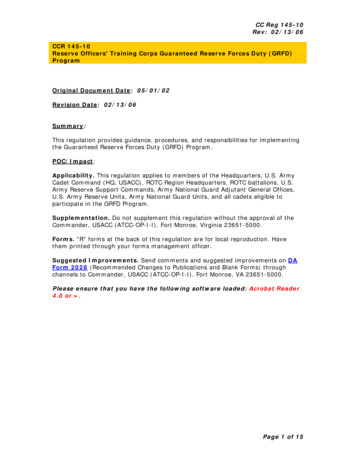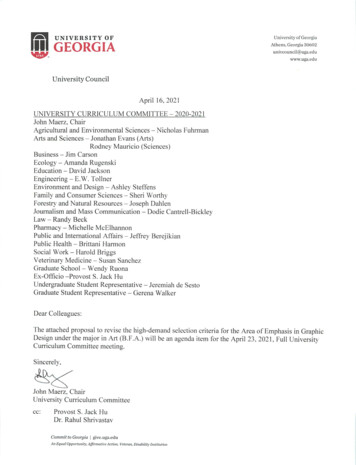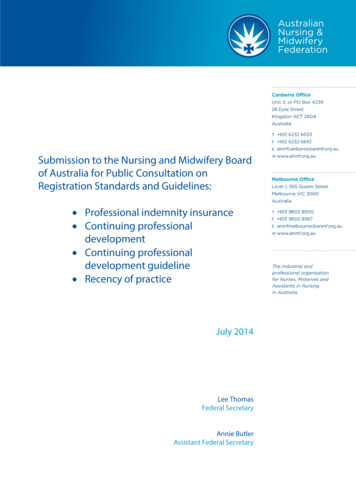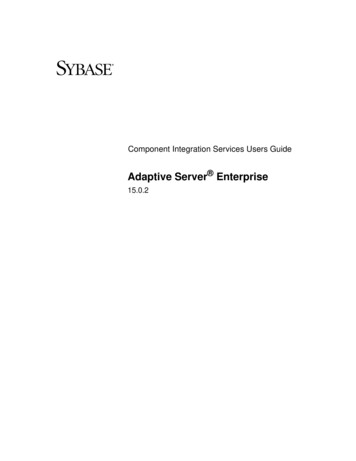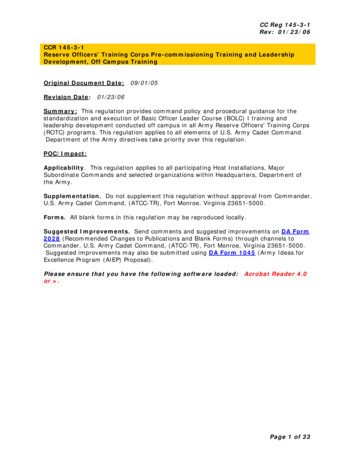
Transcription
CC Reg 145-3-1Rev: 01/23/06CCR 145-3-1Reserve Officers' Training Corps Pre-commissioning Training and LeadershipDevelopment, Off Campus TrainingOriginal Document Date:Revision Date:09/01/0501/23/06Summary: This regulation provides command policy and procedural guidance for thestandardization and execution of Basic Officer Leader Course (BOLC) I training andleadership development conducted off campus in all Army Reserve Officers' Training Corps(ROTC) programs. This regulation applies to all elements of U.S. Army Cadet Command.Department of the Army directives take priority over this regulation.POC/Impact:Applicability. This regulation applies to all participating Host Installations, MajorSubordinate Commands and selected organizations within Headquarters, Department ofthe Army.Supplementation. Do not supplement this regulation without approval from Commander,U.S. Army Cadet Command, (ATCC-TR), Fort Monroe, Virginia 23651-5000.Forms. All blank forms in this regulation may be reproduced locally.Suggested Improvements. Send comments and suggested improvements on DA Form2028 (Recommended Changes to Publications and Blank Forms) through channels toCommander, U.S. Army Cadet Command, (ATCC-TR), Fort Monroe, Virginia 23651-5000.Suggested improvements may also be submitted using DA Form 1045 (Army Ideas forExcellence Program (AIEP) Proposal).Please ensure that you have the following software loaded:or .Acrobat Reader 4.0Page 1 of 33
CC Reg 145-3-1Rev: 01/23/06Table Of ContentsChapter 1, Introduction1-1Purpose1-2Reference1-3Explanation of Abbreviations and Terms1-4Program Objectives1-5GeneralChapter 2, Leader's Training Course raining2-5Detailed InformationChapter 3, Cadet Practical Field Training (CPFT)3-1CPFT Program3-2CPFT Program Priorities/Goals3-3CPFT Initial and Closure ReportsChapter 4, Leader Development and Assessment Course (LDAC) / ce4-4Description4-5Training4-6Regimental Affiliation4-7Detailed InformationPage 2 of 33
CC Reg 145-3-1Rev: 01/23/06Chapter 5, Cadet Troop Leadership Training (CTLT) Program5-1General5-2CTLT - Platoon Leader Program5-3CTLT Internship Program5-4DCLT Program5-5Permissive Parachute Jumping5-6Security ClearanceChapter 6, Task Organization and Responsibilities6-1Headquarters, U.S. Army Cadet Command6-2ROTC Region Commander6-3Region CTLT Project Officer (CTLTPO)6-4Brigade Commander6-5Brigade CTLT Project Officer (CTLTPO)6-6Professor of Military Science (PMS)6-7Cadet6-8Liaison and Non-ROTC personnelChapter 7, Administrative Detail7-1Orders7-2Travel7-3Arrival and Departure Procedures7-4Cadet Identification Card7-5ROTC Liaison Visits7-6Hospitalization and Cadet Health Benefits7-7Discipline7-8Emergency Leave7-9Lodging7-10CTLT/CPFT Messing and Subsistence7-11Clothing and Equipment7-12Awards7-13Information Activities7-14Pay and Allowances7-15CPDT Counseling and Evaluations7-16After Action Review and Program EvaluationPage 3 of 33
CC Reg 145-3-1Rev: 01/23/06AppendicesAAbbreviationsBReferencesCDuties and Responsibilities of Cadet SupervisorsDCadet Command Circular 145-04 (LTC)ETAC Officer SOP (LTC)FCPFT Coordinator ResponsibilitiesGSample CPDT LNO Tasking- CompletedHSample CPFT MOI- CompletedIQualification Criteria for the Combat Divers Qualification Course (CDQC)JCadet Command Circular 145-05 (LDAC)KWarrior Forge TAC SOPLWarrior Forge SOPMWarrior Forge Educators VisitNCTLT/DCLT Memorandum of Instructions (MOI)OThe CTLT/DCLT Host Unit/Agency Commanders GuidePSummer Training Budget SOPQPassport to GoldPage 4 of 33
CC Reg 145-3-1Rev: 01/23/06Chapter 1, Introduction1-1. Purpose.This regulation sets policies, assigns responsibilities, and providesguidance for planning, developing, and executing the Senior Reserve Officers TrainingCorps (SROTC or ROTC) Off Campus Training Program. It standardizes the implementationof Pre-commissioning (Common-Core) Training (PCT), mandatory training requirements,and leadership development within U.S. Army Cadet Command (USACC).1-2. References.References listed in Appendix B.1-3. Explanation of Abbreviations and TermsAbbreviations also referenced in the Table of Contents Glossary.1-4. Program Objectivesa. Increase each cadet's leadership developmentb. Familiarize cadets with the command, training, administration, and logistical functionsexpected of junior officers.c. Expose cadets to the on-duty and off-duty environment of junior officers.d. Familiarize cadets with the Junior Officer Development System and Officer ProfessionalManagement System (OPMS).e. Provide cadets an opportunity to attend active duty skill enhancement schools andplatoon leader positions with active Army units.1-5. Generala. ROTC Off-Campus Training consist of the following: Leader's Training Course (LTC),Cadet Professional Development Training (CPDT), and Leader Development andAssessment Course (LDAC).b. The Leaders Training Course is the Army’s two-year ROTC program entry point (lateralentry). Through the Leaders Training Course, students without ROTC basic courseexperience can earn placement credit for the basic course and qualify for advancedcourse entry. It is often their first exposure to Army life on an active Army installationand one of the few opportunities where cadets from various parts of the country undergo acommon, high-quality training experience. For more information on LTC, refer to chapter2 of this regulation.c. The Cadet Professional Development Training (CPDT) program is comprised of cadettraining in Army schools/courses and with active Army units. The CPDT programsupplements campus training with practical leader development experiences and someadditional skill identifier awarding courses. The CPDT program consists of two subprograms, Cadet Practical Field Training (CPFT) and Cadet Troop Leader Training (CTLT).CPDT opportunities promote leader development. Residual effects include improvingPage 5 of 33
CC Reg 145-3-1Rev: 01/23/06recruiting, retention, and incentives to deserving cadets. PMSs must prepare, select andsend to CPDT only those cadets with the highest potential for completing the CPDT trainingand commissioning. For more information on the Cadet Professional Development Trainingprogram, refer to chapters 3 and 5 of this regulation.d. The Cadet Command SROTC mission is to commission the future officer leadership ofthe U.S. Army. Within that framework, the LDAC mission is to TRAIN cadets to Armystandards, DEVELOP leadership, and Assess officer leadership potential. LDAC is the singlemost important training event in the career of a cadet. It is often their first exposure toArmy life on an active Army installation and one of the few opportunities where cadetsfrom various parts of the country undergo a common, high-quality training experience.For more information on LDAC, refer to chapter 4 of this regulation.e. All cadets require a current physical examination in order to contract andparticipate in Cadet Professional Development Training (CPDT). All new ROTCmedical exams for contracting and CPDT attendance will be reviewed andqualified/disqualified by DoDMERB. Battalions will use Concorde facilities for scholarshipexams, non-scholarship exams, and CPDT exams. Request for additional evaluations andlaboratory tests can be obtained at local MTF or at the applicant's expense. CadetCommand will not reimburse costs incurred through the use of other than the approvedfacilities. Battalions that are currently using MTFs will continue to do so until further noticeunless a Concorde exam site has been established in your location. Battalions who arehaving access issues with MTFs and desire a Concorde exam site will contact the CadetCommand Surgeon office via e-mail. All ROTC exams will be performed using theDoDMERB exam forms, DD Form 2351/2492. The MEPs forms and DD 2807/2808are no longer used effective 3 Jun 02. An ROTC exam approved by DoDMERB after 3Jun 02 can be used for the scholarship, non-scholarship or CPDT training.(1) At the time of contracting, the Battalions have the capability to print theQualified/Disqualified DoDMERB physical via the DoDMERB website for LDAC, AirborneSchool, etc. The exam is available on the DoDMERB website when a finalqualification/disqualification decision is rendered.(2) DoDMERB physicals that do not require a waiver by Cadet Command can beused for attendance at airborne school. PMSs will not send cadets to airborne school withunresolved waivers. Airborne school must approve the medical exam of any ROTC cadetwhose DoDMERB physical required a medical waiver by Cadet Command.(3) Every Battalion is authorized 3 DoDMERB password holders. When theBattalion requires a new password, they will contact Cadet Command, Directorate ofInformation Management.¶Chapter 2, Leader's Training Course (LTC)2-1. Mission.The mission of the Leader's Training Course is to qualify and motivate prospective cadets(who do not otherwise qualify for lateral entry) to enroll and contract in the AdvancedCourse. It also provides the opportunity for selected high school graduates to qualify forentry into the Advanced Course if they attend a military junior college (MJC) and intend tocontract in the Early Commissioning Program (ECP).Page 6 of 33
CC Reg 145-3-1Rev: 01/23/062-2. Responsibility.The Eastern Region Commander plans and conducts LTC. The program of instruction willbe coordinated between HQ USACC and the Region Commander(s) to accomplish the sametraining (tasks) to the same standards required for the on-campus program during theBasic Course.2-3. Description.LTC is divided into four phases.a. The Soldier First Phase. This is a Basic "introduction to the Army" to teach cadetsskills and knowledge necessary to successfully participate in the next three phases. Cadetshave described this phase as "teaching them what right looks like". Specifically, cadetslearn military customs and courtesies such as saluting, how to wear the uniform and howto march.b. The Warrior Leader Phase. This part of their training covers adventure training, whichbuilds both cadet self confidence and unit esprit-de-corps. Focus is on individual skills as aprecursor to learning group dynamics. Cadets learn basic military skills in order to functionas a small group member.c. The Bold Leader Phase. This phase is the course's "Capstone Exercise". Cadets areexposed to squad level operations where cadre assesses the cadet's leadership ability in afield environment. The Field Training Exercise is intentionally tough and introduces theelement of stress. Throughout the exercise cadets encounter physical and mental obstaclesthat challenge them as a person, cadet and leader.d. The Future Leader Phase. This portion of the cadet's training introduces them to thesocial aspect of the Army. Final briefings are conducted as well as a Family Day inconjunction with a cadet-run graduation ceremony.2-4. Training.LTC training is conducted by committees composed of ROTC cadre, Reserve Componentsoldiers, and tasked FORSCOM unit personnel. Training includes the Field Leader'sReaction Course, Confidence Training, First Aid, Rappelling, Stream Crossing, Map Reading,Land Navigation, Orienteering, Basic Rifle Marksmanship, and Squad Lanes (paintball).2-5 Detailed Information.For detailed information on LTC refer to Appendix D (Cadet Command Circular 145-04(LTC)) and Appendix E (TAC Officer SOP), and Appendix Q (Passport to Gold).Chapter 3, Cadet Practical Field Training3-1. Cadet Practical Field Training (CPFT) Program.a. This program provides cadets an opportunity to attend active duty skill enhancementschools and specialized training courses with active Army personnel. Opportunities toparticipate in the CPFT Program promote leadership skills and can impact on retention ofdeserving cadets. PMSs must prepare, select, and send to CPFT only those with thehighest potential for completing the courses listed below and being commissioned.Page 7 of 33
CC Reg 145-3-1Rev: 01/23/06b. CPFT Training includes the following:(1) Basic Airborne Course (BAC).The Basic Airborne Course (BAC) is a three-week program conducted by theAirborne Department, US Army Infantry Center, Fort Benning, Georgia. Successfulcompletion of the BAC qualifies cadets to wear the Basic Parachutist Badge and beeligible for an airborne qualified CTLT rborne/(2) Air Assault School (AAS).The US Army Air Assault School is a 10-day course of instruction conducted at FortCampbell, KY, United States Military Academy, West Point, NY; Fort Drum, NY andSchofield Barracks, HI. The school focuses on combat assault operations involvingassociated equipment and U.S. Army rotary-wing aircraft. Students range fromprivate to general officer and each must adhere to the same high standards ofperformance to earn the Air Assault Badge. All personnel must attend classes andpass oral, written and physical exams. Allocations vary throughout the year.Successful completion of AAS qualifies cadets to wear the Air Assault Badge.http://www.campbell.army.mil/aas/air assault school.htm(3) Combat Survival Training (CST).CST is a 20-day program conducted at the U.S. Air Force Academy, ColoradoSprings, CO. It affords cadets the opportunity to practice employing the principles,procedures, techniques and equipment that enhance survival and evasion prospects,regardless of hostile or adverse weather conditions. The course objective is to teachthe skills that facilitate the return of friendly forces without organized rescue andrecovery assistance.(4) Combat Diver Qualification Course (CDQC).CDQC trains cadets to become combat divers using both open-circuit and closedcircuit systems. The course is four-weeks and four-days in length and training isconducted in Key West, FL. To participate in the CDQC (Phase II), cadets must firstsuccessfully pass a 10-day Pre-Scuba (Phase I) training program. Cadet Commandwill conduct the Pre-Scuba training.(5) Cadet Field Training (CFT).Cadet Field Training is hosted by the United States Military Academy. This eightweek program is designed to develop the leadership skills of sophomore cadets.Only MS II cadets are eligible to attend. Seven weeks of CFT are conducted atCamp Buckner, New York, which is a part of the U.S. Military Academy Installation,and one week at Fort Knox, KY, for Mounted Maneuver Training (MMT).(6) Mountain Warfare Training (MWT).MWT is a two-week program conducted at Fort Ethan Allen, VT that requires cadetsto perform mountaineering tasks in a realistic tactical mountain environment. MWTintroduces cadets to the techniques and tactics required to operate in a mountainousenvironment under hostile conditions. Emphasis is on strenuous field exerciseswhere cadets learn mountain-related skills. This is a challenging course wherephysical stamina and conditioning are keys to success.Page 8 of 33
CC Reg 145-3-1Rev: 01/23/06https://www.benning.army.mil/AMWS/(7) Northern Warfare Training (NWT).NWT is a two-week program conducted at Fort Richardson, AK that is designed totrain cadets in the skills required for conducting military operations in typicalmountainous terrain found throughout the world. Emphasis is placed on basicmilitary mountaineering skills. Physical fitness and stamina are keys to s.html(8) United Kingdom Officer Training Course (UKOTC).UKOTC is a two-week program hosted by the British Army at The University ofCambridge and the University of London in England. Cadets are integrated withBritish cadets and train together as squads and platoons. Training includes weaponsfiring, adventure training and field training exercises.(9) Sandhurst Competition (United States Military Academy).The concept of Sandhurst is an annual military sweepstakes competition. Each 9member team performs a series of military tasks while moving non tactically, asrapidly as possible over a partly prescribed route of approximately 9 kms, in lessthan 3 hours. Scores are determined by the squad's performance on each militarytask, on the total time required for the squad to negotiate the course, andcompletion of the Commandant's Challenge event. Briefings at task sites areminimal to enable squads to complete the course as quickly as possible.c. See Appendix H, Sample CPFT MOI for more details on administering the CPFTprogram.3-2. CPFT Program Priorities/Goals.a. MSL II cadets have first priority. The Cadet Command goal is for 75% of the CPFTallocations to be filled by MSL II cadets.b. MSL III cadets have second priority. The Cadet Command goal is for no more than25% of the CPFT allocations to be filled by MSL III cadets.c. Region Commanders must approve any CPFT allocations filled by other than an MSL IIor III cadet. Once approved, courtesy copy the CPFT coordinator at HQ, Cadet Commandfor tracking purposes and to ensure change is made in CCIMS.3-3. CPFT Initial and Closure Reports.Cadet Command Personnel (LNO) supervising cadets participating in CPDT training willsubmit an initial and closure report to the CPFT project manager annotating the reporttime of the cadet and departure time of each cadet following the military schoolgraduation. The report will include the name of the cadet, battalion of the cadet, arrivaltime and departure time. Reports will be forwarded to the CPFT coordinator, HQ, CadetCommand, Attn: Deputy Chief of Staff, G-3. The CPFT coordinator will forward reports toRegions who will then disseminate the information.Page 9 of 33
CC Reg 145-3-1Rev: 01/23/06Chapter 4, Leader Development and Assessment Course (LDAC)/Warrior Forge4-1. Mission.The mission of the Leader Development and Assessment Course is to train cadets to Armystandards, develop leadership, and evaluate officer potential. LDAC is the most significanttraining and evaluation event in ROTC. Training is complex, challenging, and rigorous andis conducted in a stressful training environment.4-2. Responsibility.The Western Region Commander plans and executes LDAC as directed in the standardprogram of instruction (POI). LDAC supplements on-campus instruction and training andprovides practical experiences and opportunities for cadets to develop and demonstratetheir leadership potential. The CG USACC must approve recommendations for changes tothe POI or command guidance concerning the conduct of LDAC.4-3. Attendance.Attendance and successful completion of LDAC is a pre-commissioning requirement.Cadets generally attend LDAC at the conclusion of their MSLIII year. LDAC attendancemay be deferred to the end of the MSLIV year with the approval of the BrigadeCommander. Medical problems, hardship, or compelling academic reasons for defermentare generally considered for approval; reasons of cadet convenience, lack of adequatepreparation, poor or failing APFT score, overweight, or PMS preference are not consideredfor approval.4-4. Description.LDAC or operation WARRIOR FORGE is the most important training event for an ArmyROTC cadet. The 33-day training event incorporates a wide range of subjects designed todevelop agile and adaptive leaders and evaluate leadership ability. The challenges arerigorous and demanding, both mentally and physically. WARRIOR FORGE testsintelligence, common sense, ingenuity and stamina. These challenges provide a newperspective on an individual's ability to perform exacting tasks and to make difficultdecisions in demanding situations. WARRIOR FORGE places each cadet in a variety ofleadership positions, many of which simulate stressful combat situations. In each position,cadets will receive evaluations from platoon tactical and counseling (TAC) officers andnoncommissioned officers. In addition to proving their leadership ability, cadets mustmeet established standards in physical fitness, land navigation, communication, combatpatrols and demonstrate their proficiency in many other military skills. Cadets must excelat WARRIOR FORGE to be considered competitive for active dut
c. Expose cadets to the on-duty and off-duty environment of junior officers. d. Familiarize cadets with the Junior Officer Development System and Officer Professional Management System (OPMS). e. Provide cadets an opportunity to attend active duty skill enhancement schools and platoon
